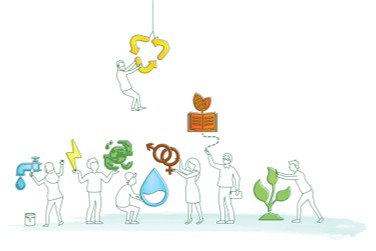Enterprise Profile
This type of enterprise focuses on one thing: a scalable and replicable product. It is close to its end beneficiaries, and aims at serving as many of them as possible. It focuses on increasing its share of market rather than its share of wallet through a scaled operation.
Business Model Features
The business model focuses on offering products, which are tangible items sold on a specific market such as items that allow the consumer to access safe drinking water. The enterprise operates mainly a B2C business, meaning that it aims to sell the product to end consumers. It is important for the enterprise to understand who the consumer is and maintain a flexible operation that can respond to changing market conditions.
Context and Environment
Focusing on selling as many of its products as possible, the enterprise operates in both urban and rural areas. It is successful in penetrating both high- as well as low-income customers, and could also serve rural BoP markets. Many enterprises in this typology operate in less developed countries, but a few also operate globally with a broad and diversified product offering.
Impact Potential
The enterprise reaches the end customers directly with their products, having a water-related impact in customers’ lives. Many in this typology operate in the water purification and distribution sector, or hygiene and sanitation. The potential to create impact, particularly for the BoP and more marginalized groups is likely to be substantial.
Some of the enterprises also deploy a franchise model, and due to their wide reach in urban and rural areas, can also create valuable job opportunities for women, young people, and minorities.
A strong impact performance is highly beneficial if the entrepreneur aims to approach impact-oriented investors as well as results-based financing.
Potentially relevant SDG Targets
Water-related impact
SDG 6.1 By 2030, achieve universal and equitable access to safe and affordable drinking water for all.
SDG 6.2 By 2030, achieve access to adequate and equitable sanitation and hygiene for all and end open defecation, paying special attention to the needs of women and girls and those in vulnerable situations.
SDG 6.b Support and strengthen the participation of local communities in improving water and sanitation management.
Similarly, entrepreneurs could focus on areas in waste management or agriculture where high impact can be achieved by overcoming barriers end-customers face.
Social impact
SDG 5.5 Ensure women’s full and effective participation and equal opportunities for leadership at all levels of decision-making in political, economic and public life
SDG 8.5 By 2030, achieve full and productive employment and decent work for all women and men, including for young people and persons with disabilities, and equal pay for work of equal value.
SDG 8.6 By 2020, substantially reduce the proportion of youth not in employment, education or training
SDG 8.8 Protect labour rights and promote safe and secure working environments for all workers, including migrant workers, in particular women migrants, and those in precarious employment
Team and Experience
The enterprise has worked over an extended period (more than 4 years) on developing the business model and has been operational in their target market for at least 3 years. The product has been continually improved by R&D or is backed by in-depth technical and production expertise within the team.
Being a client-centric model, it is important for the team to have relevant marketing and sales experience (combining more than 5 years professional experiences in the team), and finance experience to not only manage the operation but also secure funding.
Financial Profile
Since enterprises in this typology have simple product offerings with scaled operation, they have a higher variable cost than fixed cost, leading to lower capital expenditure requirement. Typically, the enterprise has already reached break even or is planning to do so within the next 3 years. Many of them also have recurring revenue streams through, for instance, subscription models, making the future revenue flow more predictable.
However, there can be the exception of those wanting to finance their scaling to the rural area, for which a higher CapEx is required and the break-even takes longer. In such cases, either the profitability or the impact needs to justify the long runway until break-even and is likely to appeal to a different investor group.
What are your Financing Options?
Grant and Results-based Finance (Impact bond, SIINC, performance-based loan, performance-based contract)
Given the enterprise’s focus on serving customers, it is able to secure grants when it can demonstrate impacts in terms of new and/or enhanced access to water, sanitation, and health. This is much more viable to do in comparison to other SDGs such as water resource management or increased water quality, given that impact targets are closely linked to operational targets.
Equity or alike (common stock, preferred equity, convertible note)
Due to the enterprise’s established business model and scalable operation, it is likely that it attracts equity or equity-like investors. It is especially relevant to have finance expertise within the team – someone who is able to put together a convincing financial model and speaks the language of investors – is critical to financing at this stage. Many equity investors interested in the water sector are also looking for impact, indicating that an enterprise that is able to demonstrate a track record (and not just the potential) of water-related impact has a higher chance to secure equity.
Debt or alike (debt, venture debt, subordinated loan, revenue-based loan)
Due to the enterprise’s established business model and scalable operation, it is also likely that it attracts debt or debt-like investors. In order to access debt financing, the enterprise needs a reliable cash flow and long-term financial viability, indicating that it requires recurring revenue streams that have been locked in.
For enterprises that require a longer runway until the next funding round, venture debt is interesting to look into. For those that are affected by seasonality, a revenue-based loan is particularly interesting.

